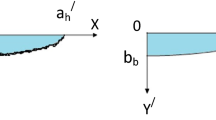Summary
Water application pattern, WAP, is one of the most important factors that determine the instantaneous and the cumulative application rates of moving irrigation machines. The mathematical background of a procedure to predict and design the WAP of moving irrigation machines is introduced. It includes a mathematical analysis of the effect of pressure head, height and spacing between emitters on the WAP, and a nomograph that presents this analysis graphically and illustrates the design procedure of the application pattern of irrigation machines.
Similar content being viewed by others
Abbreviations
- P(ŝ)a:
-
water application rate at a normalized radial distance ŝ from the emitter [m/s]
- ka:
-
number of linear segments needed to represent the pattern
- ŝ ≡ s/Ra:
-
normalized radial distance from the emitter
- Ra:
-
wetted radius [m]
- sa:
-
radial distance from the emitter [m]
- n j ≡n i/ha:
-
normalized water application rate at point
- j, ha:
-
maximum water application rate [m/s] n j water application rate at point j [m/s]
- ϋ j =m j/Ra:
-
normalized radial distance of point j from emitter
- m ja:
-
radial distance of point
- ja:
-
from emitter [m], CWAP
- (x)a:
-
Cumulative Water Application Pattern: amount of water per unit area applied at a distance
- xa:
-
from the travel path of the emitter [m3/m2]
- xa:
-
distance from the travel path of the emitter [m]
- T xa:
-
time of application at a distance
- xa:
-
from the travel path of the emitter [s]
- va:
-
velocity of propagation of the machine [m/s]
- k 1a:
-
the outmost linear segment that its radial distance from the emitter
- m k1a:
-
is smaller than the distance of the travel path from the emitter
- x, T ja:
-
time at which the
- j tha:
-
linear segment (ring) stops influencing the point located at a distance
- xa:
-
from the emitter
- π 1, π 2, π 3a:
-
dimensionless numbers derived by dimensional analysis
- ua:
-
water jet velocity [m/s]
- ga:
-
gravity acceleration [m/s2]
- da:
-
nozzle diameter [m], v kinematic viscosity [m2/s]
- Ha:
-
emitters height [m]
- α, βa:
-
regression analysis coefficients
- Paa:
-
Pattern fit coefficient for water application
- F(r)a:
-
normalized desired water application pattern [1/m]
- f(r)a:
-
normalized actual water application pattern [1/m]
- La:
-
common distance on which
- F(r) and f(r)a:
-
are defined [m], SP spacing interval between emitters [m]
- DSa:
-
dimensionless spacing interval between emitters
- ΔDSa:
-
variation of dimensionless spacing interval
- ΔPaa:
-
variation of Pa coefficient
- Pa:
-
pressure head [kPa]
References
Alchanatis V, Amir I (1990) A pattern fit coefficient for water application. Irrig Drain Syst 4: 29.
Bittinger MW, Longebaugh RA (1962) Theoretical distribution of water from moving irrigation sprinkler. Trans ASAE 5: 26.
Hart WE (1972) Subsurface distribution of nonuniformly applied surface water. Trans ASAE 15: 656.
Keller J (1990) Sprinkler and trickle irrigation. Van Nostrand Reinhold, New York.
Kincaid DC (1982) Sprinkler pattern radius. Trans ASAE 25: 1668.
Kincaid DC, Nabil M, Busch JR (1986) Spray losses and uniformity with low pressure center pivots. ASAE paper 86–2091.
Kohl RA, De Boer DW (1984) Drop size distribution for a low pressure spray type agricultural sprinkler. Trans ASAE 27: 1836.
Morin J, Benjamini Y (1977) Rainfall infiltration into bare soils. Water Resource Res 13: 813.
Thooyamani KP, Norum DI, Dubets S (1987) Application rates and uniformity under center pivot sprinkler irrigation systems using spray nozzles. Cand Agr Eng 29: 149.
Author information
Authors and Affiliations
Rights and permissions
About this article
Cite this article
Amir, I., Alchanatis, V. Procedure for predicting and designing moving sprinkler application patterns. Irrig Sci 13, 93–98 (1992). https://doi.org/10.1007/BF00193986
Received:
Issue Date:
DOI: https://doi.org/10.1007/BF00193986




